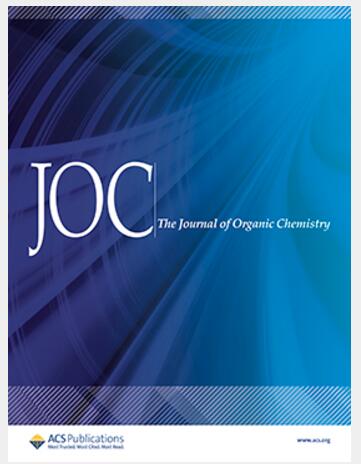如何以三种方式形成双键:σ、π-异对称双基的反应三位一体。
IF 3.6
2区 化学
Q1 CHEMISTRY, ORGANIC
引用次数: 0
摘要
σ,π-异对称双自由基是由炔-烯的Myers-Saito环化反应形成的,具有不同的化学环境。在本研究中,在烯二炔分子的烯位引入马来酰肼,利用这些基团的吸电子性质,使烯二炔重排为烯-烯,从而通过环芳构化生成σ,π-异对称二自由基。基于实验结果和计算分析,我们确定了σ,π-异对称双自由基的三个竞争反应途径:(1)双自由基对氢原子的抽离,(2)π-自由基与亲核试剂的相互作用,(3)σ-自由基与亲核试剂的相互作用。在路径1中,两个自由基中心都能很容易地抽离氢,其中σ-自由基表现出明显的优先性。在路径2和路径3中,亲核反应过程中核心芳烃环的畸变通过形成Möbius-like共轭框架导致自由基轨道的正交性被破坏,为电子转移提供了有效途径,从而促进了双自由基猝灭和亲核加成。本文章由计算机程序翻译,如有差异,请以英文原文为准。
How to Form Two Bonds in Three Ways: Reaction Trinity of σ,π-Heterosymmetric Diradicals.
σ,π-Heterosymmetric diradicals are typically formed through the Myers-Saito cyclization of enyne-allene, featuring distinct chemical environments for the two radicals. In this study, maleic hydrazide was introduced at the ene position of enediyne molecules, leveraging the electron-withdrawing properties of these groups to facilitate the rearrangement of enediyne into enyne-allene, which subsequently leads to the generation of σ,π-heterosymmetric diradicals through cycloaromatization. Based on experimental results and computational analysis, we identified three competing reaction pathways for σ,π-heterosymmetric diradicals: (1) hydrogen atom abstraction by diradicals, (2) interactions of π-radicals with nucleophiles, and (3) interactions of σ-radicals with nucleophiles. In path 1, both radical centers can readily abstract hydrogens, with the σ-radical, showing a clear preference. In paths 2 and 3, the distortion of the core aromatic ring during the nucleophilic reaction leads to the disruption of the orthogonality of the radical orbitals through the formation of a Möbius-like conjugated framework, providing an efficient pathway for electron transfer and thereby facilitating both diradical quenching and nucleophilic addition.
求助全文
通过发布文献求助,成功后即可免费获取论文全文。
去求助
来源期刊

Journal of Organic Chemistry
化学-有机化学
CiteScore
6.20
自引率
11.10%
发文量
1467
审稿时长
2 months
期刊介绍:
Journal of Organic Chemistry welcomes original contributions of fundamental research in all branches of the theory and practice of organic chemistry. In selecting manuscripts for publication, the editors place emphasis on the quality and novelty of the work, as well as the breadth of interest to the organic chemistry community.
 求助内容:
求助内容: 应助结果提醒方式:
应助结果提醒方式:


